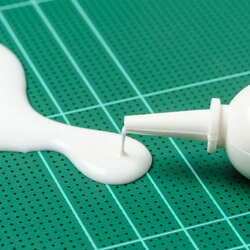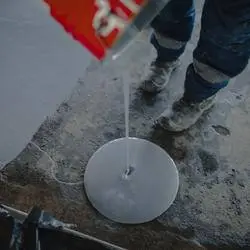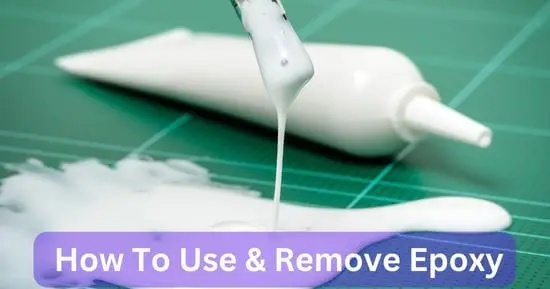Epoxy is one of the most commonly used adhesives used in many industries to hold things together, and it can seal almost anything. This guide will teach you how to use and remove epoxy from your projects. No worry about using epoxy and removing epoxy from any surfaces. What should I do if resin gets on their skin by accident? We will address your inquiries in this article.
Epoxy is strong glue that can be used to fix a wide range of things, from shaky furniture to broken floors. These hardening glues are great for challenging jobs, but if you set them up wrong, they could get you in trouble.
Find the best way to remove the epoxy stain for the type of material affected to keep the surface from getting worse. Learn how to use and remove epoxy by reading on.
Table of Contents
ToggleHow To Use Epoxy
To successfully use epoxy glue, adhere to these basic instructions.
- Roughen the surfaces you want to bind using sandpaper. Alternately, gently file the surface. Make sure debris, dust, or oil is removed from the surfaces.
- Get the application syringe ready. Cut the end tips first. The plunger should then be depressed while the syringe end is turned up. Give the air bubbles around 30 seconds to rise.
- Pull the plunger back. Put the cap back on after cleaning the application tip.
- Quickly combine the epoxy resin and hardener. Within a few minutes, they ought to be thoroughly combined.
- Prepare your mixture. Don’t worry if you don’t have a mixing nozzle. A double plunger evenly distributes the resin and hardener over a disposable surface.
- Lightly coat the areas you’re connecting with glue. Make sure they are situated correctly, then firmly push them together. Check the product instructions since set and cure periods might vary.
- Carefully take away any surplus epoxy. Utilize methylated alcohol and a cloth to remove any extra epoxy.
Here we discuss some uses of epoxy:
Epoxy Use In Metal
For bonding metal, epoxy glue may be a fantastic and powerful tool. Additionally, it avoids the inconvenience of soldering or welding. Epoxy adhesives are available in many stores.
This product may fix various metal items, including garden chairs and vehicle license plates. It sets in five minutes and is fast and straightforward to apply. Once it has solidified, you may drill or sand the surface, and the repair will be completely invisible. It will seem like new!
Epoxy Used In Wood
Have you noticed any cracks in your wooden mantle or damaged pieces of furniture? Epoxy Repair: Wood, for example, is an epoxy glue mainly designed for mending wooden surfaces.
This practical two-part epoxy resin hardens in five minutes and resists moisture. The product is best for various wooden surfaces, including MDF and pine, and may be used indoors and outside. Once it has dried, the surface may be drilled or sanded to remove any traces of the repair.
Epoxy Used In Plastic
Epoxy glue is the solution for fixing plastic, whether it’s a piece of furniture or an automotive component!
The Epoxy Repair: Plastic is a strong epoxy that can quickly fill up fractures and fix plastic products. This item is a 2-part epoxy glue that is water resistant and may be applied to various polymers, such as acrylic, fiberglass, and polystyrene.
Epoxy Use In Other Materials
Epoxy adhesives are surprisingly adaptable; it appears that epoxies may be used on almost everything, from leather to wood! We suggest Repair All Purpose 5 Minute Epoxy if you want to buy a product that can be used on different materials.
This epoxy glue with a rapid curing time works well with the following materials: wood, metal, glass, ceramic, rubber, etc.
How To Remove Epoxy
Sometimes we need to remove epoxy, so we will discuss how to remove epoxy.
Remove Epoxy From the Skin
Using disposable gloves is a helpful first line of protection when working on an epoxy job, but mishaps may still occur. To prevent the epoxy from curing on your skin, try to remove it as soon as possible.
- Put gentle pressure on the area while rubbing it with a vinegar-soaked paper towel or cloth.
- Be careful when putting acetone or nail polish remover that contains acetone on a paper towel and using it the same way.
- In a pinch, citrus-based hand cleaners that don’t need water can also remove epoxy from your skin. Mechanics often use these cleaners to get rid of grease.
Note: After you get the epoxy off, carefully wash the area and put hand lotion on it to help soothe and heal your skin.
Quickly And Safely Remove Epoxy
Sometimes, we want to remove epoxy items attached to another surface. Additionally, certain lower-grade epoxies may degrade with time, necessitating the hardened epoxy’s removal and adding new material. So here we discuss some tips to remove epoxy.
Remove Epoxy From Plastic Or Glass
Epoxy is used to patch cracked window glass and repair damaged plastic parts, which can be challenging to remove from such sensitive surfaces.
When the epoxy is loose, apply some isopropyl alcohol (rubbing alcohol) to a paper towel and massage it over the area. If the epoxy is still difficult to remove, a more potent solvent, such as paint thinner or denatured alcohol, may be applied to the site using a cloth to break the binding. The epoxy can then be scraped off the surface using a scraper tool.
Use a clean, moist cloth to remove any leftover solvents from the surface once the epoxy has been removed.
Remove Epoxy From Concrete Or Wood
Epoxy is often used to finish floors, but the resin may sometimes end up in unexpected locations. Acetone may penetrate the porous surface to surround and loosen the epoxy, making it simple to pull away when removing epoxy from wood or concrete.
Strong epoxy residues on wood may be easily scraped by applying heat to the area.
Wear leather gloves to protect your hands, and place a heat gun a few inches above the damaged region at a temperature of roughly 200 degrees Fahrenheit. Move the nozzle in tiny circular motions to heat the epoxy without burning the wood. While the epoxy drippings are still tacky, proceed with a scraper.
Remove Epoxy From Hard Surfaces And Metal
Many previously stated removal methods also work on epoxy that accidentally dropped on metal or other hard, non-porous surfaces, including metal door jams or your beloved toolbox.
Tough epoxy is frozen in an aerosol can of spray refrigerant, becoming brittle and simple to scrape away with a scraper. This chemical is also hazardous; use protective clothing such as safety goggles, gloves, and respirators to prevent contact with the fumes, and only operate in well-ventilated areas.
Remove Epoxy From Clothes
If you get epoxy on your work clothes by accident, you can get it off without hurting the fabric. When acetone or paint thinners are used on fabrics, they may lose their color or fall apart. Scraping or other abrasive methods can easily damage the delicate weave of the material.
After the cloth has been in hot water for a short time, pull it out with tongs and use a gentle peeling motion to get rid of the epoxy.
Cotton and linen won’t get damaged by boiling water, but wool may shrink or melt synthetic fabrics. Before washing in cold water, try rubbing vinegar on the epoxy or letting it soak for a while to loosen it.
Conclusion
Epoxy glue is strong and designed to connect things permanently. So it is difficult to remove it.
This article discusses the uses of epoxy in metal, wood, plastic, and other materials. We have also discussed the removal methods of epoxy.
I hope this article is informative for you while removing and using epoxy. Thanks.
More Guides:






